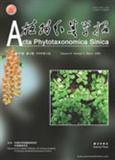HOU Yuan-Tong, LU Fa-Jun, QU Chang-You, LI Fa-Zeng
2006, 44 (2): 165–167
Three new species in Polygonum section Polygonum (Polygonaceae) from Xinjiang, China, are described and illustrated. Polygonum urumqiense F. Z. Li, Y. T. Hou & F. J. Lu is similar to P. aviculare L. in habit, but differs by having flowers densely clustered and spicate in the upper part of branches, stamens 5–6, and two types of achenes (the longer one densely and irregularly granulate on surface). Polygonum tachengense F. Z. Li, Y. T. Hou & F. J. Lu is similar to P. aviculare in the flowers not forming a raceme in the upper part of branches, the stamens 8, and the achenes striate-granulate on surface, but differs by the leaf blades linear-lanceolate, the midvein and lateral veins conspicuously raising abaxially, the ochreae longer, up to 1.1 cm, 15–20-veined, the flowers 3–6 clustered together in the upper axils of branches. This species is also similar to P. patulum M. Bieb. in the erect stem, and the flowers 3–6 clustered together in the axils of the upper part of branches, but differs by the midvein and lateral veins of leaves conspicuously raising abaxially, the ochreae longer, up to 1.1 cm, 15–20-veined, the leaves in the upper part of branches not becoming smaller gradually, and the flowers clustered in the upper axils of branches not forming a raceme, and the achenes striate-granulate on surface. Polygonum shiheziense F. Z. Li, Y. T. Hou & F. J. Lu is similar to P. argyrocoleon Steud. ex Kunze in the erect stem, the 3–6 flowers clustered in the upper axils of branches, the stamens 8, and the slightly smooth achenes, but differs by the midvein and lateral veins of leaves conspicuously raising abaxially, the ochreae longer, up to 1.1 cm, 15–20-veined, and the flowers clustered in the upper axils of branches not forming a raceme. This species is also similar to P. tachengense in habit, but differs in the leaves borne in the upper part of branches becoming smaller gradually and the smooth, slightly shiny achenes. The pollen morphology, leaf epidermal characters and achene micromorphology of the three new species and their relatives were comparatively observed under the scanning electron microscope (SEM).










